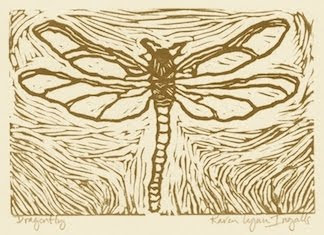
Dragonfly soft block print • © 2003 Karen Lynn Ingalls
Have you been intrigued by the possibilities of block printing? (If not, I hope you will be... it is a wonderful art form to work with.) Or do you like stamping, and feel like getting more creative?
Iridescence, an acrylic painting created using the same dragonfly soft block
© 2010 Karen Lynn Ingalls
Block printing is kind of a next step up from stamping – and you can combine it with acrylic painting to create mixed media pieces, something I particularly enjoy (you can see it in the painting above, Iridescence). You can also use it to print on textiles – but it stands on its own as a wonderful medium.
Angel of Peace soft block print, printed as a holiday card
© 2003 Karen Lynn Ingalls
You can use it to create handprinted cards and fine art prints, which is what we'll be doing this Saturday in this year's
Soft Block Printing workshop. Soft block printing is similar to, but much easier to work with, than linoleum block or wood block printing. We'll also be using non-toxic, water-soluble inks, as well as safety cutters, which have the added benefit of allowing you more control of your cuts, and giving you the ability to cut much nicer curves.
In the workshop, we'll design and cut the block for printing, and ink and print greeting cards and fine art prints. If you'd like to come, bring along some images you might like to make prints of – drawings? photographs? We'll be carving 4" x 6" blocks.
Songbird soft block prints drying, in process, with multiple colors
© 2010 Karen Lynn Ingalls
The workshop runs from 10:00 a.m. to 5 p.m. on Saturday, August 27th, at the Calistoga Art Center, 1435 North Oak Street in Calistoga (at the Napa County Fairgrounds). Bring your lunch! You can register online at the Calistoga art center's website, at
www.calistogaartcenter.org.
You can also see photographs of the process from 2010's two-day printmaking workshop in my
August 2010 blog post. And here's a link to
Charles deLimur's block printing process, a marvelous block printing photo essay by Charles deLimur, a Calistoga artist who does Napa Valley Open Studios each year. Charley works with multiple colors and multiple printing runs, a difficult and challenging process, which he illustrates beautifully. If you click on each individual photo, you can read his commentary about the process.
If you'd like to come, I look forward to seeing you! And if you're not able to join us, think about the possibilities of block printing... it's really a wonderful medium.

















































